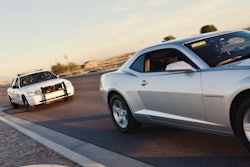According to the Department of Justice Office of Justice Programs (DOJ OJP), approximately 90 percent of the shootings involving law enforcement officers occur in low-light conditions—and "low light" doesn't necessarily mean nighttime. Low light conditions exist during daytime in places like parking garages, poorly lit buildings, and even under a thick canopy of trees in wilderness areas.
Unfortunately, most law enforcement training—including firearms training—takes place in fairly good lighting conditions. Training for low-light situations using settings and scenarios shrouded in low light is not frequently conducted at most agencies.
Combining the added difficulty of the task of shooting in low light and the relatively little time spent practicing it, officer performance typically suffers—sometimes with dangerous or deadly consequences. What are some of the challenges presented by the prospect of training for low-light operations—and more importantly, how can they be overcome?
Controlling the Environment
Live-fire range training generally takes place in one of two—or occasionally, both—venues: in a climate-controlled (often subterranean) room typically located under the department headquarters, and/or an outdoor square range on gravel or concrete surrounded by earth berms.
On an indoor range, low-light conditions can be achieved with relative ease—simply switch off the overhead lights and introduce another light source simulating a real-world scenario. In the second instance, all you have to do is wait for sundown.
Both are simple. Neither is easy.
Duane Wolfe—a police trainer and 34-year veteran of law enforcement—says, "Our biggest problem whenever we did outdoor training at night was the next morning we'd get phone calls from all the neighbors that got ticked because we're in a relatively populated area."
Dick Fairburn—a public safety professional with more than 46 years of experience and author of the book "Building a Better Gunfighter"—says, "A lot of outdoor ranges have neighbors that don't like you shooting very late."
For this and other reasons, indoor ranges are ideal, but some agencies don't take full advantage of that capability. Trainers have total control over the lighting conditions, but many typically have both the line and the targets—and sometimes the entire space in between—illuminated.
"There's no reason you shouldn't dim that down most of the time," Fairburn says. "All you need nowadays is just an LED bar in there. That's going to put out more than enough light—sometimes almost too much light."
Keeping the Line Safe
Regardless of whether low-light training is indoors or out, safety is always paramount.
Todd Fletcher—owner and lead instructor for Combative Firearms Training and 2022 ILEETA Trainer of the Year—offers some suggestions.
"When it comes to maintaining a safe training environment, there are a number of things that we encourage," Fletcher says. "One of those things is utilizing ChemLights on everyone—front and back. This gives students and instructors a way to keep track of where people are—you can see people moving around."
Fletcher continues, "Another thing we encourage is that at least instructors have a head lamp—preferably a head lamp that also has a red light so that you can do some work out there. They can turn on the head lamp and see what's going on, or for scoring targets or recording something, or even just working on a gun."
Wolfe says, "Having run the basic academy—with thousands of people at lowlight conditions—it's always one of the more stressful evenings because you've got to use your ears more than your eyes. You need to be listening very carefully for when guns are getting charged when they're not supposed to be getting charged—when guns are coming out of their holsters when they're not supposed to be coming out of their holsters. Then you've got to try to identify who it is in the low-light conditions."
One of the ways in which that can be addressed is to increase the instructor to student ratio. Fletcher says that when he's conducting training during daylight, he will seek to have a 1:5 or 1:6 ratio, but during low-light training he'll make that closer to 1:3 or 1:4.
"The more eyes and ears of instructors I can get out there, the safer the training environment's going to be," Fletcher says. "We want to be able to run a safe training environment and still challenge our people, and in order to do that you just need more people with eyes and ears tuned for that safety side of running the training."
Wolfe says that a higher instructor to student ratio on the line certainly helps, he stresses vigilance on everyone's part, "making sure everybody's staying safe, everybody's listening to and following directions, and doing what they're supposed to do."
Fairburn says, "We always ran a 1:4 ratio of instructor to trainees and I think that's good even at night. But a lot of places don't—a lot of places are one to six or one to eight."
Fairburn says that's probably not good enough.
"If you're doing night training, you need more range eyes out there, keeping track of what's going on," he says.
Making Incremental Improvements
In the quest to improve officer safety—and performance—during low-light deadly-force encounters, many agencies have added emerging new technologies such as red-dot optics, tritium sights, and weapon-mounted flashlights.
Fairburn says, "I think night sites are an absolute must. I think the percentage of weapon bound of lights for uniform cops is pretty high. Even if you have a weapon-mounted light, I would have a second one too. The problem with the weapon-mounted light that bothers me is you're pointing a gun at whatever you're searching. Until you have more heightened sense of alert that something's going to go bad, you probably should be searching with a handheld light."
Fairburn cautions, however, against over-reliance on these technologies. Training, he says, is key.
"Train for failure," Fairburn says. "Train for your red dot, not working. Train for your flashlight going out."
Fletcher says, "We see somewhere between a 25% and a 50% reduction in officer performance in lower or altered lighting conditions compared to full daylight. That performance reduction can be mitigated somewhat by increased familiarity and increased training frequency and low light conditions. The more you're accustomed to performing in low light, the better you're going to be."
Wolfe adds, "Just like anything else for any cops, if you're not training and practicing regular with [low-light] don't expect miracles to happen in the middle of a confrontation. You can practice those techniques on your own anytime you want, but any additional live-fire training—above and beyond department does—it's only going be beneficial as you're spacing out periodically through the year, so you're consistently training those techniques."
As has been previously stated in this space, law enforcement agencies should take into account the fact that a great many—if not the majority of—officer-involved shootings take place in low-light or altered-light conditions. With this in mind, it stands to reason that a greater emphasis could and should be placed on preparing officers for this eventuality.
















